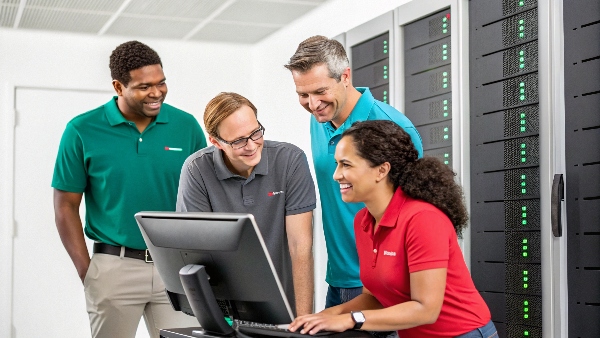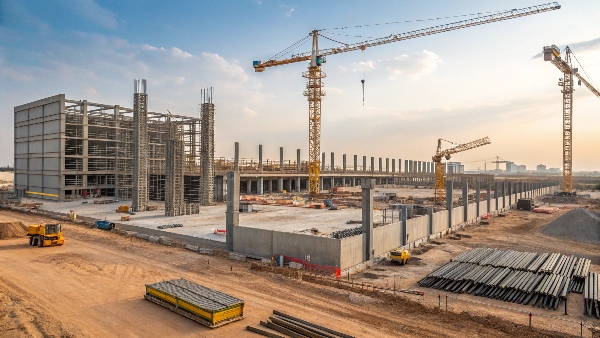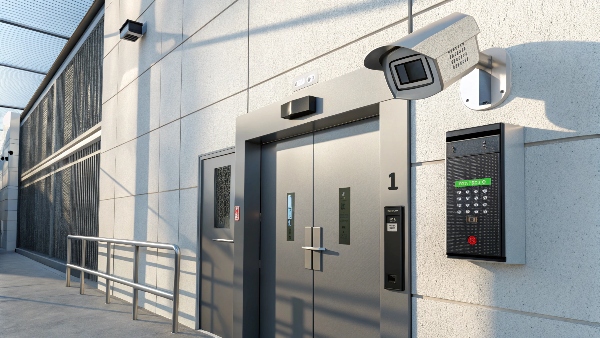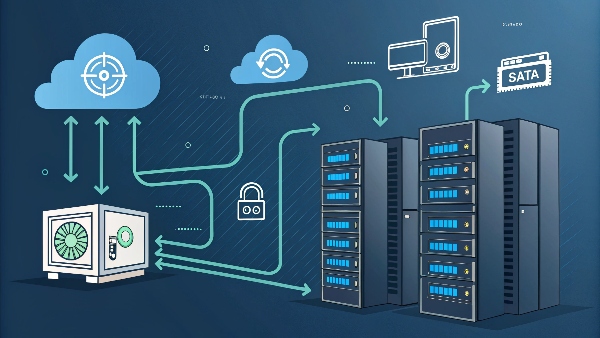Curious about data center careers but unsure if it's a good fit? The environment seems complex, maybe even a bit intimidating from the outside. Is it the right path for you?
Yes, working at a data center can be a rewarding career with good stability and opportunities for growth, especially for those interested in technology, engineering, or critical facility operations. It offers a chance to be at the heart of the digital world.

Transition Paragraph:
The digital world runs on data centers, these unseen engines of modern life. As someone at Daopulse who has been deeply involved with their power infrastructure for over a decade, I've seen the incredible dedication and skill of the people who keep these complex facilities running smoothly. My insight is that data centers utilize various uninterruptible power supply (UPS) solutions, from compact rack-mounted UPS units for individual server cabinets to large, scalable modular UPS systems for overall facility protection, and understanding this power backbone is key for anyone working within them. This field offers unique challenges and equally unique rewards. So, let's take a closer look at what it's really like to work in this critical industry.
What are some challenges of building a data center?
Thinking of building a data center, but it seems like a huge undertaking? The costs and complexities can quickly become overwhelming if you're not prepared. What major hurdles will you face?
Building a data center involves significant challenges. These include massive capital investment, complex site selection, designing robust power and cooling infrastructure, ensuring top-tier security, meeting regulatory compliance, and managing long construction timelines.

Dive deeper Paragraph:
Constructing a data center is a truly monumental task, definitely not for the faint of heart. Over my years at Daopulse, I've worked closely with many clients as they navigated these intricate complexities, especially when it came to planning and implementing their critical power systems. The challenges are numerous.
First, the Capital Investment is enormous. We're talking about acquiring land, the actual building construction, and then fitting it out with power systems (which includes large UPS units like our lead-acid or lithium battery solutions, plus backup generators), sophisticated cooling systems, comprehensive security measures, and of course, all the IT hardware.
Second, Site Selection is absolutely critical. You need to find a location with access to reliable and ample power grids (often requiring multiple feeds for redundancy), excellent fiber optic connectivity for data, a low risk profile for natural disasters, and sometimes, favorable local regulations or tax incentives can play a big role.
Then there's Power & Cooling Design. This is a huge engineering challenge. You must design for current and future power needs, ensuring high levels of redundancy like N+1 or 2N for UPS systems, and plan for efficient cooling to handle the heat generated by thousands of servers. For instance, deciding between large centralized UPS units versus more distributed, modular UPS systems requires a careful analysis of expected load profiles and future scalability needs. We at Daopulse offer both types of solutions to meet these varied demands.
Here's a breakdown of some key challenge categories:
| Challenge Category | Specific Hurdles | Impact on Project |
|---|---|---|
| Financial | High upfront costs, long return-on-investment (ROI) period, ongoing operational expenses. | Potential budget overruns, difficulties securing funding. |
| Location & Site | Power availability & cost, network connectivity, land cost, environmental risks, permits. | Project delays, increased operational costs, exposure to risk. |
| Technical Design | Power density planning, cooling efficiency, redundancy implementation, future-proofing. | Operational inefficiencies, higher risk of downtime, scaling issues. |
| Construction | Long project timelines, skilled labor shortages, complex system integrations. | Delays in becoming operational, potential quality control issues. |
| Regulatory | Obtaining permits, environmental compliance, industry-specific standards (e.g., for healthcare or finance). | Legal challenges, operational restrictions, potential fines. |
Procurement Managers and System Integrators involved in these massive projects need partners they can absolutely trust. They seek reliable suppliers, like Daopulse, for critical components such as our CE, RoHS, and ISO certified UPS systems, ensuring that at least the power backbone of their new facility is solid and dependable from day one.
What are your thoughts on data center load growth?
Data demand is exploding, putting immense pressure on data centers. How can these critical facilities possibly keep up with this relentless, ever-increasing load growth? It's a major concern for everyone in the industry.
Data center load growth is a significant and continuous trend, primarily driven by AI, widespread cloud computing adoption, and the Internet of Things (IoT). This requires careful capacity planning, ongoing investment in energy-efficient technologies, and highly scalable power solutions, such as modular UPS systems, to effectively manage these increasing power demands.

Dive deeper Paragraph:
The rapid growth of data center loads is a constant topic of discussion in our industry. At Daopulse, we are always innovating and adapting our OEM/ODM UPS solutions to meet these evolving needs effectively. The demand for data processing capabilities and vast storage capacities is not just growing steadily; it's accelerating at an astonishing pace.
Several key technological advancements are fueling this expansion:
- Artificial Intelligence (AI) & Machine Learning (ML): Training complex AI models and running AI-driven applications require immense computational power. This directly leads to the deployment of very high-density server racks, each consuming significant amounts of electricity.
- Cloud Computing: The continued, large-scale migration of businesses and services to cloud platforms means that hyperscale data centers, operated by major cloud providers, are constantly expanding their footprint and power consumption.
- Internet of Things (IoT): Billions of connected devices, from smart home gadgets to industrial sensors, are generating a continuous and massive stream of data. All this data needs to be collected, transmitted, processed, and stored, further driving demand for more data center capacity.
This rapid growth presents several distinct challenges for data center operators and designers:
- Power Density Increases: Server racks are consuming more power per square foot than ever before. This increased density puts considerable stress on existing power distribution networks within the data center and on the cooling systems designed to remove the generated heat. This is a scenario where rack-mounted UPS units can be very beneficial. They provide dedicated, clean power and protection right at the rack level, supplementing the larger facility-wide UPS systems.
- Energy Efficiency Imperative: With rising global energy costs and growing environmental concerns, making data centers more energy-efficient (achieving a lower Power Usage Effectiveness or PUE) is absolutely crucial. This focus on efficiency is a major factor in the industry's shift towards more advanced and efficient UPS technologies, such as lithium-ion battery solutions, which we specialize in.
- Scalability and Flexibility: Data center facilities need the ability to scale their power and cooling infrastructure quickly and cost-effectively to match load growth. Modular UPS systems are an excellent solution here. They allow operators to add power capacity incrementally, in step with actual demand, rather than making a huge, speculative upfront investment in capacity that might go unused for years. We've successfully helped many of our clients implement such scalable and flexible power solutions.
The implications of this ongoing load growth are very clear: future data centers must be designed with flexibility, scalability, and energy efficiency at their core. Thinking about power infrastructure in a modular and adaptable way, from individual racks right up to the entire facility, is rapidly becoming standard practice in the industry.
| Growth Driver | Impact on Data Center Load | Key Power Solution Consideration |
|---|---|---|
| AI / Machine Learning | Very high-density power needs | Efficient high-capacity UPS, localized power options (e.g., rack UPS) |
| Cloud Computing Expansion | Massive overall scale increase | Large, highly reliable, and modular UPS systems, robust grid connections |
| Internet of Things (IoT) | Distributed data generation | Power solutions for edge data centers, efficient small-footprint UPS units |
| 5G Network Rollout | Low latency processing needs | Reliable power for edge compute nodes located close to cell towers |
What is the role of data center security in infrastructure?
Data centers house incredibly valuable digital assets and sensitive information, making them prime targets. A security breach could be catastrophic, leading to severe financial loss and reputational damage for any business relying on them. How vital is security?
Data center security is a critical and foundational infrastructure component. It encompasses robust physical measures like access control and surveillance, alongside comprehensive cybersecurity strategies including firewalls and intrusion detection systems. Its purpose is to protect against unauthorized access, data breaches, and operational disruptions. Security is integral, not an optional add-on.

Dive deeper Paragraph:
Security isn't just an afterthought or a layer you simply add on top of a data center; it's deeply woven into the very fabric of its design and operational infrastructure. At Daopulse, while our primary focus is on delivering highly reliable power through our CE, RoHS, and ISO certified UPS systems, we are acutely aware that the critical IT equipment we protect is often safeguarding incredibly sensitive and valuable data. Therefore, the overall security of the facility is paramount.
Data center security fundamentally operates on two main fronts:
-
Physical Security: This is all about meticulously controlling and monitoring physical access to the facility itself and to the sensitive equipment housed within its walls.
- Perimeter Security: This includes robust fences, secure gates, vehicle access barriers, and often, security patrols.
- Access Control Systems: Multi-factor authentication is standard, often requiring badges, biometric verification (like fingerprint or palm scans), and PIN codes at multiple entry points. "Man-trap" portals, where only one door can be open at a time, are common to prevent tailgating.
- Surveillance Systems: Comprehensive CCTV camera coverage of all critical areas, both inside and outside the facility, often with 24/7 real-time monitoring by security personnel.
- On-site Security Guards: Trained security professionals are typically present around the clock.
- Rack-level Security: For enhanced protection, many facilities offer locked server cabinets or secure cages for individual clients or specific high-value equipment.
-
Cybersecurity: This focuses on protecting the data, applications, and network infrastructure from a vast array of digital threats.
- Firewalls: Advanced, next-generation firewalls are deployed to inspect and block unauthorized or malicious network traffic.
- Intrusion Detection/Prevention Systems (IDS/IPS): These systems actively monitor network traffic for suspicious activity and can automatically take steps to block potential threats.
- Network Segmentation: The network is often divided into isolated segments to limit the potential impact of a security breach in one area from spreading to others.
- Regular Security Audits and Penetration Testing: Independent security experts are often engaged to proactively identify and address vulnerabilities.
- Data Encryption: Robust encryption protocols are used to protect sensitive data both when it's stored (at rest) and when it's being transmitted (in transit).
For Procurement Managers and System Integrators, ensuring that their chosen data center provider has implemented stringent, multi-layered security measures is just as important as verifying they have reliable and redundant power systems. A power outage can cause significant downtime and financial loss, but a major security breach can have far-reaching and devastating financial, legal, and reputational consequences. It's also worth noting that the reliability of systems like our UPS solutions also contributes indirectly to overall security; if critical systems are down due to a power loss, security monitoring capabilities and access controls might also be impacted. That's why consistent, clean, and uninterrupted power from certified UPS units is such a foundational element of a secure and resilient data center.
| Security Layer | Examples of Measures | Primary Purpose |
|---|---|---|
| Perimeter | High fences, secure gates, vehicle barriers, infrared detection. | Provide the first line of defense against unauthorized physical intrusion. |
| Facility Access | Biometric scanners, smart card readers, man-trap portals, visitor logs. | Strictly control and log who enters any sensitive areas of the facility. |
| Room/Zone Access | Additional access controls for specific data halls or colocation areas. | Implement granular access control within the data center building. |
| Rack Level | Individually locked server cabinets, secure cages within data halls. | Protect individual servers or client-specific IT equipment. |
| Network/Cyber | Firewalls, IDS/IPS, SIEM systems, data encryption, anti-malware. | Defend against a wide range of cyber threats and prevent data breaches. |
What is the meaning of data center backup?
Data is undeniably critical for modern businesses, but what happens if that valuable information is lost or becomes corrupted? Without proper, regularly tested backups, a hardware failure, human error, or a cyberattack could mean permanent data loss, which is often a disaster.
Data center backup refers to the comprehensive process of copying and archiving critical data to protect against potential data loss. This loss could result from hardware failures, accidental human errors, malicious cyberattacks, or natural disasters. It involves regular backup schedules, storing copies securely (often off-site), and having well-defined recovery plans.

Dive deeper Paragraph:
Data center backup is an absolutely fundamental pillar of any robust data protection strategy and is essential for ensuring business continuity. It's far more than just occasionally copying a few important files; it's a highly systematic, planned, and regularly executed process. As a long-standing provider of OEM/ODM UPS systems at Daopulse, we ensure that the power supplied to these critical backup processes is stable and uninterrupted, because a backup operation failing midway due to a power glitch effectively defeats its entire purpose.
Here’s a deeper look into what "data center backup" truly means:
- Data Redundancy vs. True Backup: It's very important to clearly distinguish between these two concepts. Technologies like RAID (Redundant Array of Independent Disks) provide data redundancy against individual disk failures within a server or storage array. However, RAID is not a backup. A true backup is a separate, independent copy of your data that is stored in a different physical location, and ideally on different media.
- What Gets Backed Up?: The scope of backups is comprehensive. It typically includes application data, critical databases, complete virtual machine images, operating system configurations, user files, and sometimes even system state information.
- Common Backup Types:
- Full Backup: This involves copying all selected data every time the backup job runs. It's the most complete but also the most time and storage-consuming.
- Incremental Backup: This method copies only the data that has changed since the last backup job was run (whether that last job was a full or another incremental backup).
- Differential Backup: This copies all data that has changed since the last full backup was performed.
- Backup Media & Targets: Historically, magnetic tapes were a very common medium for backups, and they are still widely used for long-term archiving due to their cost-effectiveness and durability. Modern backup solutions often utilize disk-based storage systems (for faster restores), dedicated backup appliances, cloud backup services, or a hybrid approach combining on-premises and cloud storage.
- The 3-2-1 Rule: This is a widely recognized best practice in data backup. It advises keeping at least 3 copies of your important data, on at least 2 different types of storage media, with at least 1 of those copies stored off-site (in a geographically separate location).
- Recovery Point Objective (RPO) & Recovery Time Objective (RTO): These are critical metrics defined by the business.
- RPO: This defines the maximum acceptable amount of data loss, measured in time (e.g., "we can afford to lose up to 1 hour's worth of data"). This dictates how frequently backups must occur.
- RTO: This defines how quickly systems need to be restored and operational after a disaster or outage. This influences the choice of backup technology and the complexity of recovery procedures.
The reliability of the power infrastructure, including dependable UPS systems (such as our versatile rack-mounted UPS1 units for specific servers or our scalable modular UPS2 solutions for larger segments), is absolutely critical for successful backup operations. Backup jobs can be very resource-intensive, consuming significant processing power and network bandwidth, and they can often take a considerable amount of time to complete, especially for large datasets. Ensuring that these crucial backup processes complete without any interruption from power sags, surges, or outages is essential for data integrity. For a Procurement Manager at a hospital, for example, ensuring that patient records are backed up reliably and consistently is non-negotiable. The UPS system supporting that backup infrastructure is a critical, indispensable link in that vital chain of protection.
| Backup Aspect | Description | Importance for Data Protection & Business Continuity |
|---|---|---|
| Backup Strategy | Defines what data is backed up, when, how often, and recovery objectives (RPO/RTO). | Ensures comprehensive and tailored data protection. |
| Backup Technology | Software applications, hardware (disk arrays, tape libraries, cloud storage) used. | Directly affects backup speed, restore capabilities, and cost. |
| Backup Verification | Regularly testing backups by performing trial restores to ensure data is recoverable. | Confirms that backups are actually usable in a crisis. |
| Data Retention Policy | Defines how long different types of backups are kept, based on business and regulatory needs. | Ensures compliance and enables long-term historical recovery. |
| Off-site Storage | Storing at least one copy of backups in a geographically separate and secure location. | Protects against site-wide disasters like fire, flood, or major outages. |
Conclusion
Working in a data center offers a stable, tech-focused career path. Understanding its construction challenges, immense load growth, critical security needs, and comprehensive backup systems helps everyone appreciate this vital infrastructure.

